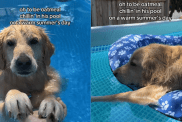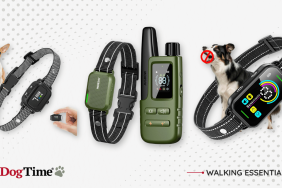Heeling a dog on-leash offers the most controlled manner of walking with a dog. It is most useful when cruising crowded sidewalks or when other dogs and animals are around. For many dogs, unfortunately, on-leash heeling is the most unpleasant command (having the highest correction/command ratio of any other obedience instruction), so much so, that heeling around the block becomes a drag in both senses of the word. The dog must think there is a jerk at both ends of the leash.
Sadly, some trainers teach on-leash heeling using non-specific (non-instructive) leash-corrections from the outset. Certainly, in some situations, a leash-correction is ideal for enforcing an already learned command, but it has absolutely no place in teaching either the meaning or the relevance of our instructions. Incessant, non-instructive physical corrections destroy the dog’s spirit. Many dogs become dejected the instant they hear the instruction “Heel.” And the owner wonders why? And then, the owner has to go to a motivational training workshop to re-motivate a dog, which was more than adequately motivated before they started training!
To start heeling instruction by enforcing compliance on-leash using physical prompts and punishments takes much longer and tends to produce a Jekyll and Hyde performance. The dog may act like a perfect angel on-leash, but as soon as the leash is removed, the dog is history. The dog quickly learns that its owner can not control it when out of arm’s reach.
For these and other reasons, we teach heeling on-leash as the last of five progressive steps: 1) Following off-leash, 2) Heeling off-leash, 3) Standing on-leash, 4) Walking on-leash and finally 5) Heeling on-leash.
Once your dog has mastered the principles of following and understands the specific “Hustle,” “Steady” and “Heel-Sit” commands and once it has learned not to pull when standing or walking on-leash, then off-leash heeling may be taught with nary a leash correction. Moreover, teaching dogs to heel off-leash from the outset teaches owners to control their dog using brain instead of brawn, since there is no opportunity to push and pull the dog around under the guise of training. Initial off-leash heeling also produces a more reliable dog, at which point it is a simple matter to slip on a leash and fine-tune heeling, once the dog already understands the basic underlying principles off-leash.
How to train your dog to heel on-leash
Start with your pup in a sit-stay by your left side. Hold the leash with the left hand, so that it loosely dangles a couple of inches below the point where it attaches to the pup’s collar and slip your right hand through the end loop, holding any excess leash tidily bunched up in this hand. Keep both hands on the leash at all times. As with off-leash heeling, have a bunch of treats in the left hand (if necessary) to precisely guide the pup, and have one treat in the right hand for the sit signal. Say “Rover, Heel” and/or give a heel-signal (without letting go of the leash) by moving your left hand from left to right in front of the pup’s nose, so that your left arm comes to rest comfortably in front of your waist and off you go. Quickly! The faster you walk, the easier it is. If the puppy lags or becomes distracted, quickly waggle the left hand in front of its nose, and then bring it back to lie in front of your waist.
Each time before stopping, slow down, say “Rover, Sit,” give a sit-signal with your right hand (still attached to the end of the leash) across the front of your body and in front of the pup’s nose and then, come to a halt with the pup sitting in heel position. In time, your puppy will learn to anticipate the sit signal and will sit automatically each time you slow down to stop. If necessary, use food as both a lure and a reward, and phase it out as before.
Your puppy may gradually lose attention during long and/or slow straight-away heels. To keep the pup on its toes, continually and randomly change pace and direction. Successive changes of pace are by far the best. Run up and down through the three-gears of heeling. This is convenient because, for the most part, it is difficult and sometimes dangerous to make a sudden turn when walking along the sidewalk – you’ll probably end up in the street, in a neighbor’s front yard or up a tree someplace. Open spaces are the place to practice multiple right- left- and about-turns. Happy heeling!
REMEMBER, if ever you feel it is necessary to correct your dog either 1) your dog did not understand the meaning of your instructions (possible) and/or 2) your dog did not understand the relevance of your instructions (highly probable). Every correction, reprimand or punishment is a blatant advertisement that your dog is not yet adequately trained. Do yourself and your dog a favor: go back and retrain your dog.
Integrating heeling into walks
On-leash heeling is precise and controlled. However, that is not to say we necessarily want to heel the puppy all the way around the block. “Hey! What about the sniffs and pees?” Let’s consider the dog’s very heart and soul, and think about a little olfactory gratification here and there. The walk, after all, is meant to be enjoyable – one of the biggest treats of the day for owner and dog. We do not need to be on military alert all of the time. Too much regimental heeling and your dog will become bored, frustrated and distracted, and the quality of heeling will eventually deteriorate. To maintain high-level, snappy heeling when required, 20:1 is a good walking-to-heeling ratio.
When walking, the dog is allowed to dally, to dawdle, to sniff and investigate to its heart’s content. The only proviso being that it must not tighten the leash. When heeling, the dog must perform an exact and snazzy choreography dictated by its owner. The dog must walk precisely by its owner’s side, turn when its owner turns and sit when its owner stops. When heeling, the dog should not be allowed to sniff or look around; it must pay attention. Certainly, the dog should not eliminate. (Most elimination is best done in the backyard or at least close to home, with a walk offered as the grand prize for the cutting-edge in canine eliminatory etiquette). Heeling is a formal control command used, for example, when crossing the street. We hardly want a dog to decide to defecate when hurry-heeling across a street just before the lights are about to change.
To obtain absolute attention from the dog, the owner must devote absolute attention to the dog. And this is tiring. Most people cannot heel their dog effectively for more than a couple of minutes at the most. Consequently, integrate several short, active and precise heeling sequences into a long, luxurious and enjoyable walk. Start with a 30-second, extremely active heeling sequence to blow the cobwebs out of the dog’s cerebrum, and then walk for three minutes, heel for five seconds and walk for one minute, heel for 10 seconds and walk for two minutes and so on. A good rule of thumb is to walk along the sidewalk and to heel when crossing streets or passing pedestrians, dogs or other animals.
Excerpted from How to Teach a New Dog Old Tricks, by Ian Dunbar.
Ian Dunbar is a veterinarian and animal behaviorist, founder of the Association of Pet Dog Trainers, and the author and star of numerous books and videos on dog behavior and training. He lives in Berkeley, California with his wife, trainer Kelly Dunbar, and their three dogs. The Dunbars are contributing editors to DogTime.









